Search the Special Collections and Archives Portal
Search Results
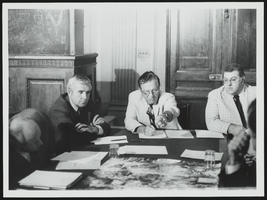
Howard Cannon at a conference table with Senator Paul Laxalt, Governor Mike O'Callaghan and others: photographic print
Date
1978-06
Archival Collection
Description
From the Howard Cannon Photograph Collection (PH-00192)
Image
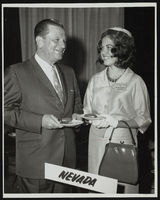
Howard Cannon pictured with Darlene Boggerly, 1964 Betty Crocker Homemaker of Tomorrow from Nevada: photographic print
Date
1964
Archival Collection
Description
From the Howard Cannon Photograph Collection (PH-00192). Stamped on verso: "9200 Wayzata Blvd. General Mills Photography Department Minneapolis"
Image
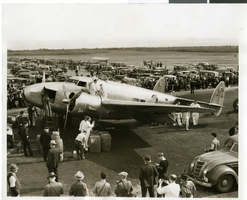
Photograph of the Lockheed 14 aircraft, Fairbanks, Alaska, July 15, 1938
Date
1938-07-15
Archival Collection
Description
The black and white view of Howard Hughes' Lockheed 14 aircraft being refueled in Fairbanks, Alaska. Typed on a piece of paper attached to the image: "C.850170 Howard Hughes' plane being re-fueled at Fairbanks, Alaska on the last lap of its round the world flight. 7/15/38."
Image
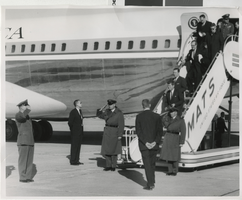
Photograph of President John F. Kennedy and Nevada Senators Howard Cannon and Alan Bible, early 1960s
Date
1960 (year approximate)
Archival Collection
Description
Alighting from the airplane are: Pres. John F. Kennedy, Nevada Senator Howard Cannon (above Kennedy) and Nev. Senator Alan Bible (above Cannon).
Image
Phase I first tower: architectural drawings, sheets 1-33, 1976 July 27; 1978 July 14
Level of Description
File
Archival Collection
Homer Rissman Architectural Records
To request this item in person:
Collection Number: MS-00452
Collection Name: Homer Rissman Architectural Records
Box/Folder: Flat File 064
Collection Name: Homer Rissman Architectural Records
Box/Folder: Flat File 064
Archival Component
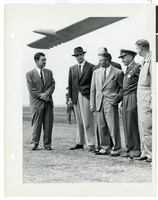
Photograph of Howard Hughes and a group of men with the Hughes XH-17, October 23, 1952
Date
1952-10-23
Archival Collection
Description
Howard Hughes (second from left) standing under the blade of the XH-17, Flying Crane with L-R: Rea Hopper, Director of the Aeronautical Division, Hughes Aircraft Company; Hughes; Clyde Jones, Director of Engineering, Hughes Tool Company Aeronautical Division; Warren Reed, Assistant; Colonel Carl E. Jackson, Air Research and Development Headquarters; Gale. J. Moore, pilot.
Image
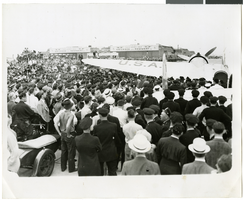
Photograph of crowds at Floyd Bennett Airfield, New York, July 1938
Date
1938-07-14
Archival Collection
Description
The black and white view of Howard Hughes' Lockheed 14 aircraft after performing its final landing on the Round the World flight at Floyd Bennett Airport, New York. Description printed on photograph's accompanying sheet of paper: "Howard Hughes reception at Floyd Bennett Field 7/14/38."
Image
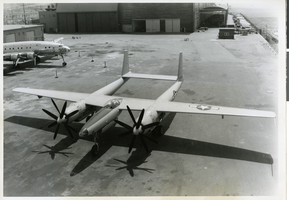
Photograph of the XF-11 prior to its first test flight in Culver City, California July 7, 1947
Date
1947
Archival Collection
Description
Transcribed from press release attached to back of photo: "NEW-DESIGN PHOTO PLANE COMPLETED CULVER CITY, Calif., July 7 -- test-flown today for the first time, the new XF-11 was revealed as one of the world's fastest long-range photographic planes. It was designed and built by Howard Hughes in conjunction with the Air Materiel command engineers. Army officials said that it can attain a speed of more than 400 miles per hour and a ceiling of more than 40,000 feet. The plane has a pressurized cabin making it unnecessary for the crew to use oxygen masks. Outstanding features include a full-span flap, unique eight-camera layout and exceptionally fast take-off." Transcribed from photo sleeve: "Howard Hughes sits in the cockpit of the XF-11, a reconnaissance plane that Hughes built and designed in conjunction with Air Materiel Command engineers. Hughes is preparing for his first test flight in Culver City, California July 7, 1947."
Image
Pagination
Refine my results
Content Type
Creator or Contributor
Subject
Archival Collection
Digital Project
Resource Type
Year
Material Type
Place
Language
Records Classification


